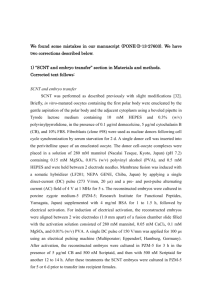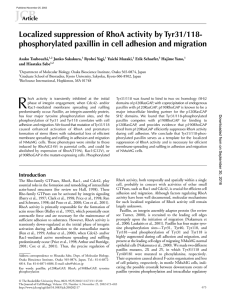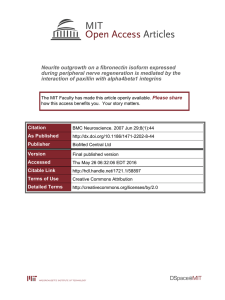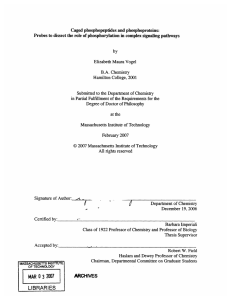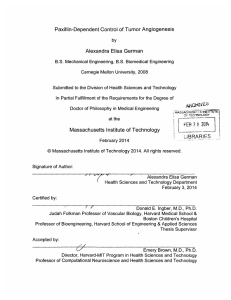File - Ryan Piche`s Portfolio
advertisement
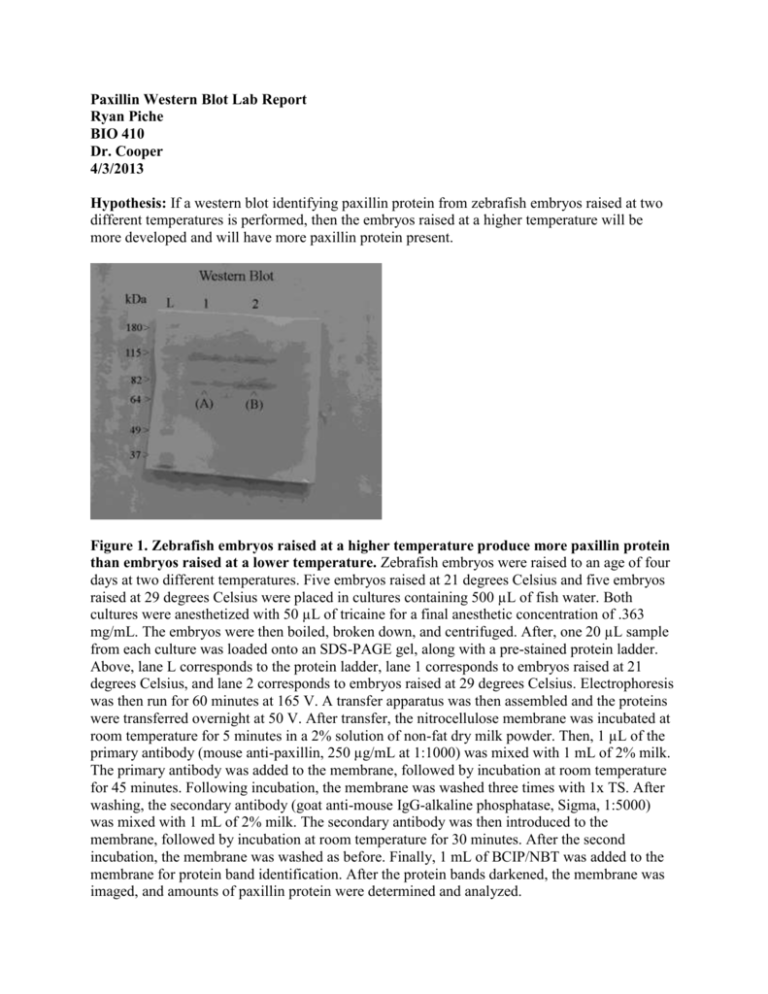
Paxillin Western Blot Lab Report Ryan Piche BIO 410 Dr. Cooper 4/3/2013 Hypothesis: If a western blot identifying paxillin protein from zebrafish embryos raised at two different temperatures is performed, then the embryos raised at a higher temperature will be more developed and will have more paxillin protein present. Figure 1. Zebrafish embryos raised at a higher temperature produce more paxillin protein than embryos raised at a lower temperature. Zebrafish embryos were raised to an age of four days at two different temperatures. Five embryos raised at 21 degrees Celsius and five embryos raised at 29 degrees Celsius were placed in cultures containing 500 µL of fish water. Both cultures were anesthetized with 50 µL of tricaine for a final anesthetic concentration of .363 mg/mL. The embryos were then boiled, broken down, and centrifuged. After, one 20 µL sample from each culture was loaded onto an SDS-PAGE gel, along with a pre-stained protein ladder. Above, lane L corresponds to the protein ladder, lane 1 corresponds to embryos raised at 21 degrees Celsius, and lane 2 corresponds to embryos raised at 29 degrees Celsius. Electrophoresis was then run for 60 minutes at 165 V. A transfer apparatus was then assembled and the proteins were transferred overnight at 50 V. After transfer, the nitrocellulose membrane was incubated at room temperature for 5 minutes in a 2% solution of non-fat dry milk powder. Then, 1 µL of the primary antibody (mouse anti-paxillin, 250 µg/mL at 1:1000) was mixed with 1 mL of 2% milk. The primary antibody was added to the membrane, followed by incubation at room temperature for 45 minutes. Following incubation, the membrane was washed three times with 1x TS. After washing, the secondary antibody (goat anti-mouse IgG-alkaline phosphatase, Sigma, 1:5000) was mixed with 1 mL of 2% milk. The secondary antibody was then introduced to the membrane, followed by incubation at room temperature for 30 minutes. After the second incubation, the membrane was washed as before. Finally, 1 mL of BCIP/NBT was added to the membrane for protein band identification. After the protein bands darkened, the membrane was imaged, and amounts of paxillin protein were determined and analyzed. 3 2.5 2 Relative Amount of 1.5 Paxillin Protein 1 0.5 0 Lower Temperature Higher Temperature Zebrafish Embryo Treament Figure 2. Zebrafish embryos raised at a higher temperature produced larger relative amount of paxillin protein than embryos raised at a lower temperature. Using the membrane image from Figure 1, relative amounts of paxillin protein were identified using ImageJ and GIMP image manipulator software. In Figure 1, band (A) corresponds to zebrafish embryos raised at 21 degrees Celsius, and band (B) corresponds to embryos raised at 29 degrees Celsius. Using protein band size calculations from the ImageJ program, relative amounts of paxillin protein were determined for both of the embryo treatments. These amounts of paxillin protein are shown relative to the amount of protein determined for the lower temperature treatment group. Results The results of the western blot show that the relative amount of paxillin for the higher temperature embryo sample is larger than the relative amount for the lower temperature embryo sample. This relates to our goal for this experiment: to determine whether or not the embryo treatment of different temperatures effected the production of the paxillin protein (Figure 2). Two distinct paxillin protein bands were identified on the membrane. At the time of analysis, it was unknown as to why two distinct bands appeared. Discussion The results of the western blot have demonstrated that the zebrafish embryos raised at a higher temperature had a larger relative amount of the paxillin protein. This is probably due to the effect temperature has on the development of the zebrafish embryo. Specifically, paxillin is a multi-domain protein that localizes primarily to sites of cell adhesion to the extracellular matrix called focal adhesions. Focal adhesions form a structural link between the extracellular matrix and the cytoskeleton (Turner 2000). Paxillin’s primary function is to act as a molecular adaptor or scaffold protein that provides docking sites for an array of signaling and structural proteins (Turner 2000). Paxillin binds to many proteins that are involved in effecting changes in the organization of the actin cytoskeleton, which are necessary for cell motility events associated with embryonic development, wound repair, and tumor metastasis (Turner 2000). Further, studies have shown that environmental factors can have a dramatic effect on fish growth. Specifically, these studies have demonstrated that higher temperatures promote muscle growth in fish (Knight et al. 2011). In zebrafish, it is known that the myogenic transcription factor MyoD is needed for muscle formation and growth. Previous studies have illustrated that after an injury to muscle fibers in zebrafish, a regenerative process occurs (Knight et al. 2011). After the injury, cells expressing Pax7 are recruited to the damaged zone and proliferate (Knight et al. 2011). These cells express myogenic markers like MyoD, which help develop new muscle fibers. All of this demonstrates the key relationship that the paxillin protein has with wound repair and cell growth. In the zebrafish embryos raised at a higher temperature, larger amounts of paxillin were observed. Considering the previous studies, the embryos raised at a higher temperature were probably more developed than the embryos raised at a lower temperature. In this case, the larger amount of paxillin makes sense, because the protein is directly related to the processes of growth and repair in the zebrafish embryo. Finally, the presence of two bands on the membrane was probably due to the fact that paxillin is a multi-domain protein. In particular, the paxillin protein has four LIM domains that it uses to attach to specific sites in the cell (Turner 2000). These multiple domains could explain the presence of two bands on the membrane, especially if any of the LIM protein domains are similar in size. Works Cited Knight K, Leslie J, Serrana DG, Hofsten JV. Fish muscle growth and repair: models linking biomedicine and aquaculture. J Exp Biol. 2011; 214: 2995-2996. Turner CE. Paxillin interactions. J Cell Sci. 2000; 113: 4139-4140.






